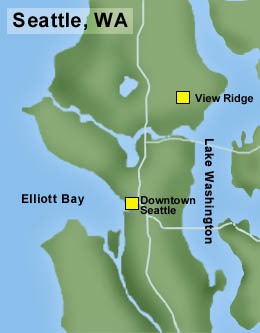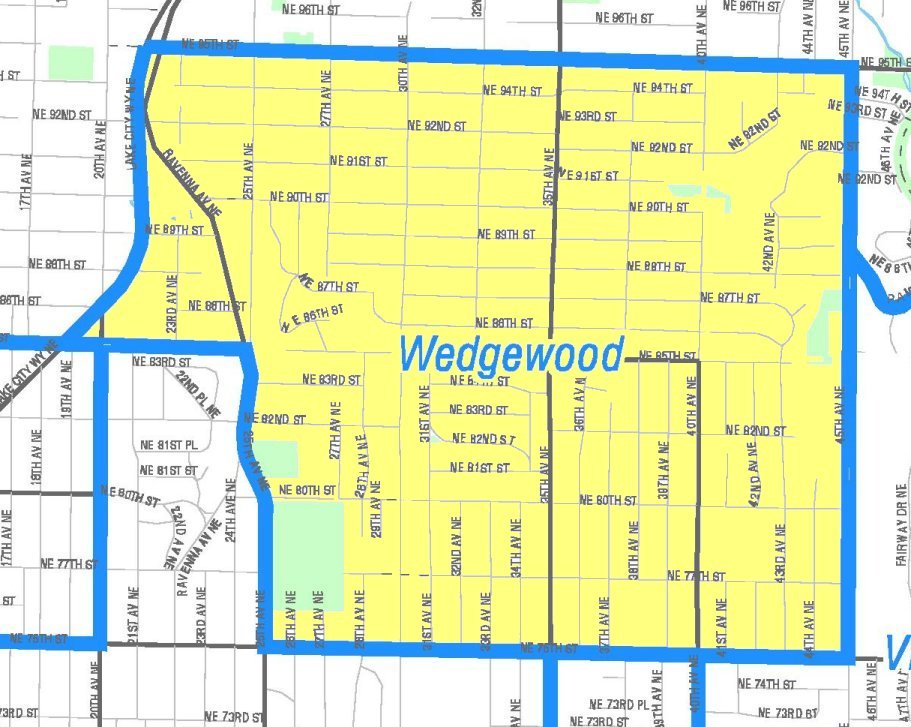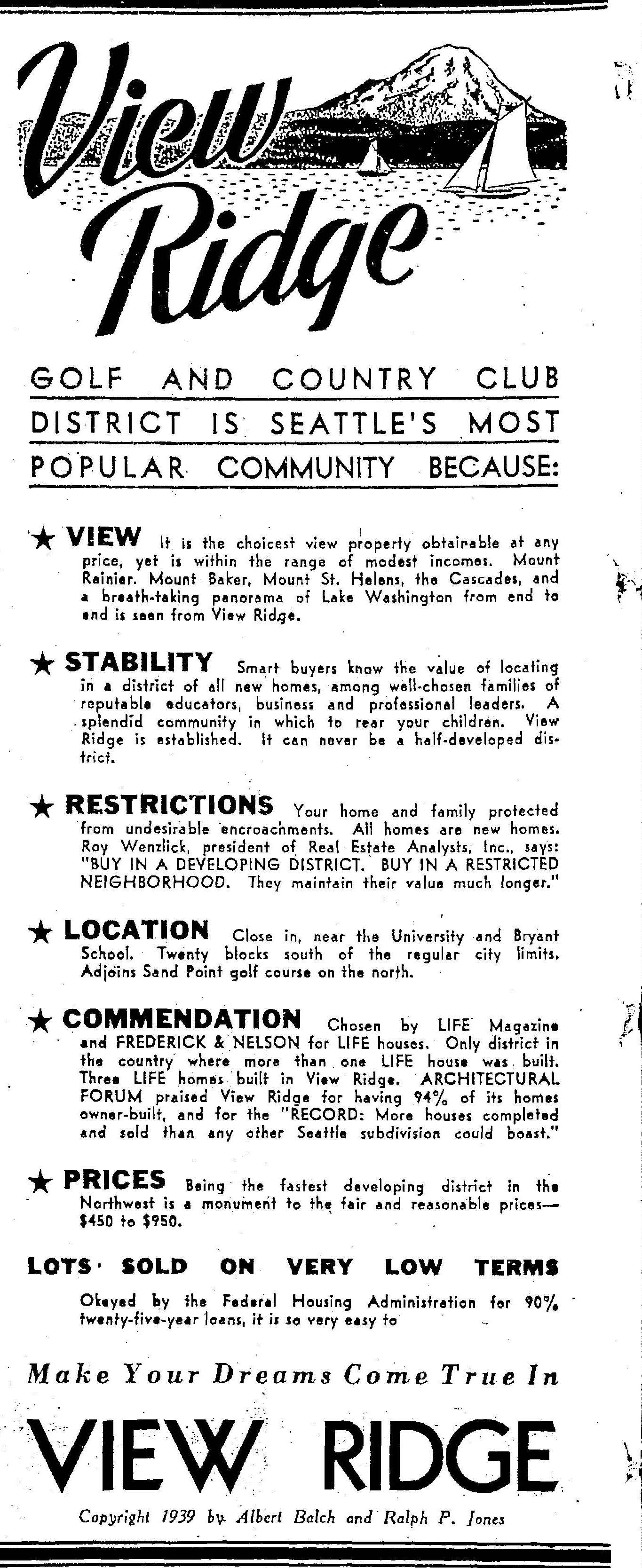The Northeast neighborhoods of View Ridge and Wedgwood were created by developer Albert Balch and his partners on land that was initially north of Seattle boundaries. The great depression had destroyed the real estate market, but things were looking more hopeful in 1935 when Albert Balch and Ralph Jones, who had been fraternity brothers at the University of Washington, decided to purchase 10 acres north of 65th street for $1,000 and begin planning the ridgetop subdivision they would call View Ridge. Balch, who had spent most of the decade since graduation working in sales, proved masterful at winning publicity for the new subdivision. After logging and grading part of the area and building several homes, sales began to pick up in 1938 and escalated through World War II and the 1940s, as Balch and Jones acquired more land and registered nine plats (legal documents showing streets and property lines) covering nearly 400 properties.
From the start Balch and Jones imposed racial restrictions. What is more, they aggressively advertised View Ridge as "Restricted Neighborhood" often explaining in Sunday newspaper ads that it was smart to buy in a restricted neighborhood: "They maintain their value much longer." Every deed in View Ridge included the following restriction: "No persons of any race other than the white race shall use or occupy any building or any lot except that this covenant shall not prevent occupancy by domestic servants of a different race domiciled with an owner or tenant.”
Wedgwood
In 1941, Albert and his wife Edith Balch joined with Maury and Eleanor Seitzer to purchase land adjoining View Ridge to the north and east. It had been owned by Seattle College (now Seattle University). The new subdivision was called Wedgwood Addition. The Balches and Seattle College administrators agreed to a set of restrictive covenants that would bind future owners of land and homes in the area: "No persons of any race other than the White or Caucasian race shall use or occupy any building or any lot except that this covenant shall not prevent occupancy by domestic servants of a different race domiciled with an owner or tenant.”
Wedgwood would continue to develop in the 1950s and 1960s, with the majority of its homes built in those decades. This was after advertising racial restrictions had become less common. The Supreme Court had ruled in a 1948 case that local courts could not be called upon to enforce racial deed restrictions and Seattle's City Council had decided that future plats must not include race restrictions. But racial discrimination remained legal and realtors and many developers continued to exclude families of color. We have not yet found Wedgwood newspaper ads from the period that explicitly did so, but as late as 1955, Albert Balch advertised homes for sale in a new subdivision he was marketing in Renton, calling it “a planned and restricted neighborhood.”
Lingering story of segregation
Since 1968, it has been illegal to discriminate in the rental or sale of housing on the basis of race. But generations later View Ridge and Wedgwood residents are overwhelmingly White. As as 2020, the census tract that contains most of the two nearborhoods (numbered tract 22 on this interactive map) counted 54 Black residents in a population of 5,948. People of Asian, Latinx, Indigenous and mixed backgrounds numbered 1,575, with Whites comprising 73% of the census tract population. This was a big improvement over 1970 when the tract was 97.5% White, but View Ridge and Wedgwood share a story with much of north Seattle. Single family neighborhoods north of the ship canal show the strongest lingering effects of the forceful segregation practices -- including deed restrictions and restrictive covenants -- that were commonplace in the middle decades of the twentieth century.
Acknowledging the past
Wedgwood is distinctive in one admirable way. On September 16, 2020, the Wedgwood Community Council published a formal statement of "Acknowledgement and Apology" which reads in part "We stand with our Black and Brown neighbors in support of true equity with the hope of creating a community that is more welcoming and safe for everyone. Further, the WCC board of trustees would like to unreservedly apologize for actions of our organization and its members throughout our existence which may have supported systemically racist institutions and systems. We are unaware of any overt racism or intentionally discriminatory actions or decisions taken by the WCC or those on the board of trustees. Nevertheless, we acknowledge that past actions to “protect” or “preserve” a restricted neighborhood born out of racist covenants, discriminatory lending practices, and exclusionary real estate practices perpetuate the inherently racist systems that shape our community – like so many others."
Four years later, September 16, 2024, the Community Council invited staff from the Racial Restrictive Covenants Project to teach about the history of racial exclusion and help neighborhood residents file Covenant Modification forms to strike illegal racially restrictive language from the chain of title. Here is an account of the visit.
Explore our map of racial change
Below is a screenshot of our interactive map showing the 2020 population of the census tract encompassing most of View Ridge and Wedgwood. Click to visit the interactive version which shows population changes for each decade from 1950-2020. Use the filters to show number counts and percentages for various racial groups.

- James N. Gregory, 2020
Sources:
David Wilma, "Seattle Neighborhoods: View Ridge — Thumbnail History", HistoryLink.org
Albert Balch five part biography by Valarie, Wedgwood in Seattle History
Agreement Respecting Restrictive Covenants Wedgwood Addition
Albert Balch advertisement for President Park subdivision in Renton, Seattle PI, April 14, 1955, p25





